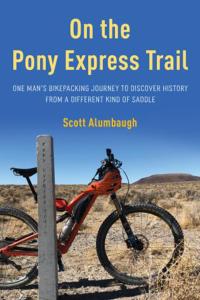Bikepacking the Pony Express
By Rebecca Hein
On the Pony Express Trail: One Man’s Bikepacking Journey to Discover History from a Different Kind of Saddle, by Scott Alumbaugh, Rowman & Littlefield Publishing Group, Inc., Lanham, Md., 2023, 271 pages. $24.95 paperback.

Starting with a brief, unvarnished history of the Pony Express, the 62-year-old author then plunges us into his adventure. His projected route is St. Joseph, Missouri to Salt Lake City, riding a mountain bike and pulling his gear-laden trailer.
Almost immediately we begin to worry about him: Will the leak in his tubeless tire sabotage his first day on the trail? Will he get so stuck in Kansas mud, miles from a house or town, that nobody can rescue him?
Will he “bonk?” This, Alumbaugh explains, is “the cyclist term for Hitting the Wall, Nothing Left in the Tank. … a feeling of absolute depletion, zero energy, helplessness, and hopelessness. The kind of feeling that first makes you feel like you’re going to die, then degenerates to where you fear you won’t.” Alumbaugh reports that he failed “to replenish the calories and nutrients I’d been furiously burning” since crossing into Nebraska, on day four.
He perks up, in part because his campsite hosts invite him to supper, delivering him from yet another night of dehydrated food. Gradually Alumbaugh establishes a better routine to keep himself fresher on the trail. And from time to time, other hospitable strangers feed him.
His object, he says, is to visit as many Pony Express stations, sites and markers as possible. However, he notes, “[T]here is no definitive list of Pony Express stations. … [T]rying to identify, locate, and name a complete list of Pony Express stations is like trying to change a tire on a moving car. Throughout the Pony’s eighteen-month existence, stations were constantly added, removed, abandoned, and relocated.”
Sometimes Alumbaugh decides not to visit a given historic site because he’s tired, or the weather is too lousy or a trail too difficult.
In a humorous conversation, a volunteer at the Pony Express Museum in Marysville, Kansas “confided that he could not figure out why anyone would be stupid enough to ride their bike the length of the Pony Express Trail. I told him he was in good company, as my partner, Lisa (who’d started identifying herself as ‘married to the nut’), felt exactly the same.”
On a typical overnight stay, usually in a public campground, Alumbaugh showers, charges his devices, washes his clothes, writes in his journal and prepares his gear for the next day’s ride. Shortly after crossing into Nebraska he comments, “One thing riding the Pony Express Route has taught me is an appreciation for functional nomenclature. A name like ‘Sand Hill Station’ doesn’t mean nearly as much when you read it in a book as it does when you read it in situ, as it were, sweating and cursing while wrestling a bike over a sand hill.”
Dust, heat and wind follow him, as they have since the beginning of his trip, through Nebraska, briefly into northeastern Colorado and into Wyoming, the last leg of his trek. Various features of Wyoming stand out: stronger wind, better-quality paved roads, more historical markers and monuments (along some stretches), spectacular scenery and longer distances between towns.
At this stage he’s become weary of camping in city parks or other public campgrounds, and dealing with the suspense and stress of “no reservation, first come first served” campsites. He notes, “[A] real bikepacker would have had no problems with this. Riders roll out a sleeping bag wherever they can. They might pitch a tent beside a barn, for example, or behind a gas station, or set up a lean-to in a clump of bushes. Bikepackers do that as a matter of course because, well, that’s bikepacking.” However, he confesses, “Unfortunately, I took up the activity way too late in life to adopt wholeheartedly its minimalist ethos.” So from that point he stays mostly in motels.
Two unforgettable episodes, at opposite extremes, lie on his path from Casper to Salt Lake City. First is the overwhelming hospitality showered on him by the Mormons at the Sixth Crossing Mormon Trail Site Visitors’ Center—on the Sweetwater River west of Jeffrey City, Wyoming. Second is the saga of crossing Burnt Ranch near South Pass, through branches of Willow Creek that require him to carry bike, gear and trailer barefoot, “sinking calf-deep in the mud, knee-deep in murky water, and then through yet another poopy maze of cow tracks on the other side. It could have been worse,” he continues, “Overland emigrants who ran out of water crossing dry stretches on the prairie actually drank out of buffalo wallows.”
The latter is a small example of his many historical digressions about emigrants and what they faced on the trail. These outnumber the Pony Express anecdotes, possibly because the record of emigrant travel is richer and more reliable, and spans a much longer time period than the Pony Express. It’s hard to decide which is more gripping: the details of the author’s ride or the wealth of history we learn along the way. Clear maps of the route complete the picture.
Available at Amazon and other online outlets
Rebecca Hein is an assistant editor at WyoHistory.org.
